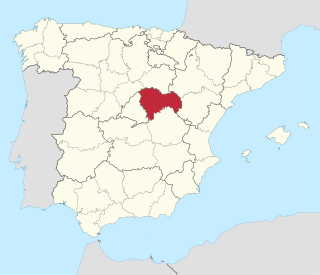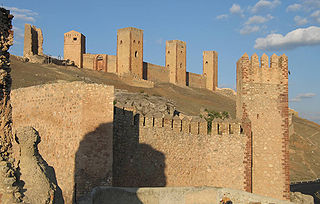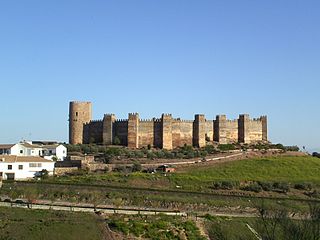
Guadalajara is a province of Spain, belonging to the autonomous community of Castilla–La Mancha. As of 2019 it had a population of 258,890 people. The population of the province has grown in the last 10 years. It is located in the centre of the Iberian Peninsula.

The Castle of Gormaz is a large castle located in Gormaz, Spain. Its current structure was built in 965 to defend the borders of the Caliphate of Cordoba. At the time of its construction, it was the largest fortress in Europe.

Jadraque is a municipality of Spain located in the province of Guadalajara, Castilla–La Mancha. The municipality spans across a total area of 38.91 km2. As of 1 January 2020, it has a population of 1,370.

The Castle of La Mota or Castillo de La Mota is a medieval fortress in the town of Medina del Campo, province of Valladolid, Spain. It is so named because of its location on an elevated hill, a mota, from where it dominates the town and surrounding land. The adjacent town came to be surrounded by an expanding series of walls in subsequent years, of which little remains.

The Marquisate of Cenete is a noble title first granted in 1491 by Queen Isabel I of Castile to Rodrigo Díaz de Vivar y Mendoza, First Count del Cid.

The Castle of Molina de Aragón is a fortification in Molina de Aragón, Castile-La Mancha, Spain. It was declared Bien de Interés Cultural in 1931.

The Atalaya Castle is a fortress in Villena, province of Alicante, southern Spain. Located over a spur of the Sierra de la Villa, in the north-western part of the province of Alicante, it commands the former frontier between Castile and Kingdom of Aragon.

The New Castle of Manzanares el Real, also known as Castle of los Mendoza, is a palace-fortress erected in the 15th century in the town of Manzanares el Real, next to the Santillana reservoir at the foot of Sierra de Guadarrama mountain range.

The Castle of Torija is a castle located in Torija, Spain. It was declared Bien de Interés Cultural in 1931. First built by the Knights Templar in the 11th century, today it serves as the headquarters of the Centro de Interpretación Turística de la Provincia de Guadalajara, the regional tourism authority.

Rodrigo Díaz de Vivar y Mendoza, was a Spanish noble of the House of Mendoza. He was the firstborn son of the powerful Cardinal Pedro González de Mendoza and went on to become the 1st Conde del Cid and the 1st Marquis of Cenete, a title he held from 1491 until his death.

Astudillo is a Spanish municipality in the autonomous community of Castilla y León belonging to the province of Palencia. It is located 29 km (18 mi) northeast of the provincial capital, and has 1,106 inhabitants (2011) with an area of 122.95 km2 (47.47 sq mi).

Castillo de Vélez-Blanco is a remarkable example of Spanish Renaissance Castle. It is located in the town of Vélez-Blanco, province of Almería, in the autonomous community of Andalusia, Spain.

The Castle of the Bishops of Sigüenza is located in Sigüenza in the Province of Guadalajara in central Spain. With foundations dating back to the 5th century, it was extended by the Moors and retaken for the Christians by Bernard of Agen in 1123.

The Castle of Burgos was a castle and alcázar, located in the city of Burgos, in the hill of San Miguel to 75 metres (246 ft) above the city and to 981 metres (3,219 ft) above the sea. This hill was the subject of archaeological surveys by General Centeno in the years 1925 and 1926 trying to find Napoleonic military files from when the French in their retreat blew up the fortress. According to the results obtained in this excavation the origin of the castle dates to the Visigoths, and its oldest parts, to the Romans.

The Castle of Ayora is located at an elevation of 552 (1,811 ft) metres above mean sea level (mamsl), in the centre of Ayora, a Valencian town. Built probably in the mid 13th century, after the Reconquista, on an ancient Arabian building. The architectural ensemble was composed of the four-storey residence-palace, two fortified towns, and one large keep, as well as other rooms for the soldiers and serfdom, aljibes and gardens. This was surrounded by around 0.62 miles of defensive walls and defensive towers.

The Castle of Coca is a castle located in the Coca municipality, central Spain. The castle was constructed in the 15th century and has been considered to be one of the best examples of Spanish Mudejar brickwork which incorporates Moorish Muslim design and construction with Gothic architecture. A scale model of the castle has been built in the Mudéjar theme park and another replica built at a ratio of 1:25 is placed in the Minimundus miniature park in Klagenfurt, Austria.

Castillo de los Duques de Alba is a castle-palace in Alba de Tormes, Salamanca province, western Spain. It is the ancestral seat of the House of Alba. Today, the castle is in ruins and can be visited by the public.

Fuensaldaña Castle is a castle in the Spanish village of Fuensaldaña, situated 6 kilometres from Valladolid, the largest city of Castile and León.

Burgalimar Castle is a historic castle in the town of Baños de la Encina, Jaén Province, Spain. It was built in the 10th century under the rule of the Umayyad Caliphate of Córdoba.



















